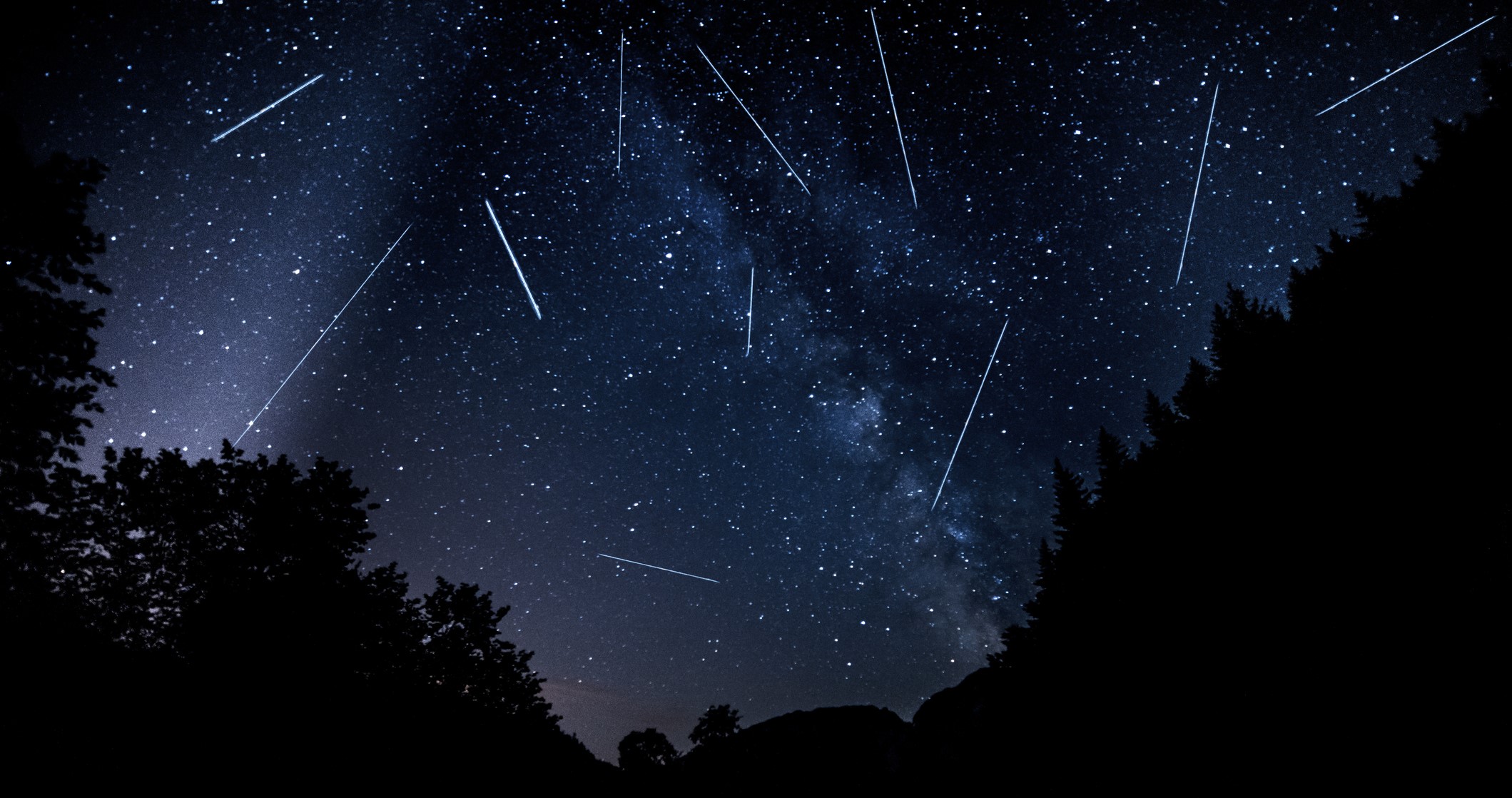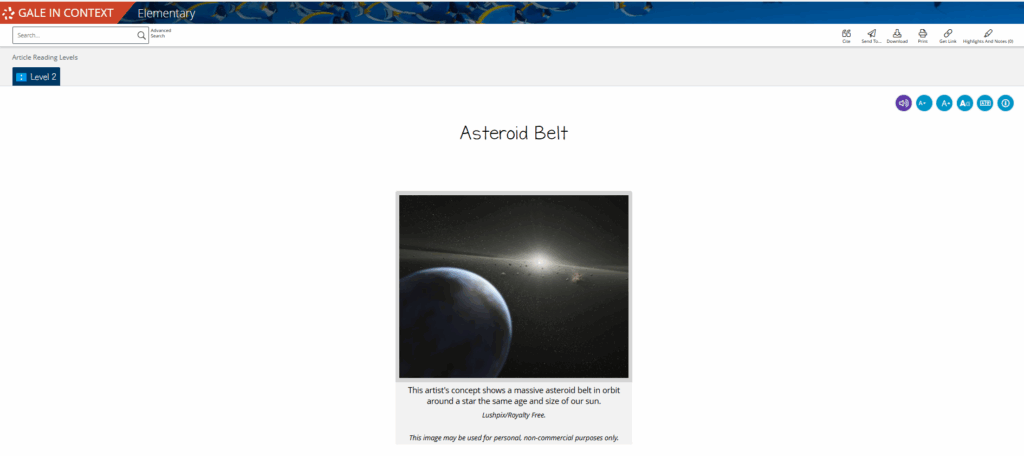Every August, the night sky comes alive with streaks of light known as the Perseid meteor shower, one of the easiest and most exciting sky shows to spot with the naked eye. In 2025, this dazzling annual event peaks from midnight on August 11 into the pre-dawn hours of August 12.
But what exactly is a meteor? What makes these “shooting stars” glow?
We’ll unpack the science behind the Perseid meteor shower and share ways to bring that knowledge into your classroom using Gale In Context: Elementary, a ready-to-use multimedia database tailored to K-5 learners.
What Is a Meteor? (And What About Meteoroids, Meteorites, and Comets?)
The Perseids may be called “shooting stars,” but it’s actually more accurate to call them meteors. Not all space rocks are meteors, however. (And they definitely aren’t stars!) Here’s a simple breakdown of the terms students are most likely to encounter when learning about this event:
- Asteroid: A space rock—usually much larger than a meteor—that travels around the Sun in a stable orbit. NASA estimates that the main asteroid belt in our solar system contains approximately 1.1 to 1.9 million asteroids that are more than 0.6 miles in diameter.
- Comet: A frozen ball of ice, rock, and dust particles that follows a stretched-out, oval-shaped, or “elliptical” path around the Sun.
- Meteor: The bright streak of light we see as a meteoroid plunges into Earth’s atmosphere. As it does so, it heats up, creating the fiery glow we call a “shooting star.”
- Meteorite: If a meteoroid is big enough to make it through the atmosphere without burning up completely and land on Earth, it becomes a meteorite.
- Meteoroid: A small piece of rock or dust floating through space. These space particles are incredibly small, sometimes no larger than a speck of sand.
Fast Facts About the Perseids Meteor Shower for Curious Elementary Classrooms
The Perseid meteor shower is a perfect opportunity to turn sky-watching into science. This quick reference guide helps you answer the questions students are most likely to ask and model how scientists learn from what they observe in the sky.
We’ve also included links to Gale In Context: Elementary to preview how this kid-friendly platform—filled with articles, images, diagrams, and read-aloud audio—can support experiential learning and help connect cosmic events to classroom content.
What Is the Perseid Meteor Shower?
The Perseid meteor shower is a yearly cosmic event triggered by Earth’s yearly journey through a cloud of space dust left behind by a comet called Swift–Tuttle (109P). As those tiny bits of dust and rock hit Earth’s atmosphere, they burn up, creating bright streaks of light across the sky. That’s what we call a meteor.
The shower gets its name because the meteors appear as if they radiate outward from the constellation Perseus. In reality, they are light-years apart, and it’s only because of our perspective of the night sky from Earth that they’ve become connected.
When Is the Perseid Meteor Shower in 2025?
The Perseids occur every year from mid-July through late August, but they peak when Earth passes through the densest part of the comet’s dust trail. In 2025, the best time to watch will be the night of August 11 into the early morning of August 12.
What Is the Best Time to Watch the Perseid Meteor Shower?
Although you might see a few meteors earlier in the evening, the best time to watch the Perseid meteor shower is after midnight in your local time zone. That’s because, in the second half of the night, the part of Earth you’re standing on is rotating to face the dust cloud. The meteors hit the atmosphere head-on, making them easier to see.
Where Can You See the Perseid Meteor Shower?
You can see the Perseids from almost anywhere in the Northern Hemisphere. To get the best view, find a dark spot away from city lights. A backyard, open field, or local park can work well—just make sure it’s safe and clear of trees or buildings that block your view of the sky.
You don’t need a telescope or binoculars. In fact, your eyes are the best tool because they let you take in as much of the sky as possible.
Why Do the Perseids Happen Every August?
The Perseids are caused by a comet called Swift–Tuttle. Every time this comet orbits the Sun, it scatters a path of debris—tiny rock and dust particles—that stay in orbit. Earth crosses that trail at the same point in its orbit every year, right around mid-August.
How Many Meteors Can You See?
On a clear, dark night during the peak of the Perseids, you might see 60 or more meteors per hour. That’s about one every minute!
Teach Elementary Students the Science Behind the Spectacle
Meteor showers may feel like magic, but this spectacular sky show is also an invitation to explore big scientific ideas. With these activities, supported by resources from Gale In Context: Elementary, students can build on their curiosity and uncover the core scientific concepts behind astronomical events.
Earth’s Orbit and the Timing of Meteor Showers
In this activity, students observe and interact with a large-scale classroom model to discover the connection between meteor showers and our planet’s path around the Sun.
Begin by setting up an elliptical orbit in your classroom using string, chalk, or tape. Divide the orbit into four quadrants labeled spring, summer, fall, and winter to represent the seasons. Mark a point in the “summer” section where Earth crosses the debris trail left by Swift–Tuttle—the source of the Perseid meteor shower.
Place a labeled object in the center to represent the Sun, and have one student or object move along the orbit to represent Earth, then pause at the marked “summer” quadrant where Earth crosses the comet’s debris trail. Prompt students to observe: What might happen at this point in the orbit? Why here?
Ask the class to consider why this location remains the same year after year and how Earth’s movement through the same part of space leads to meteor showers, such as the Perseids, occurring on a regular schedule.
Enrichment Idea:
Depending on the grade level, you can further enrich the lesson by using Gale In Context: Elementary and NASA resources to research the timing of other showers. You can challenge students to mark when and where Earth might encounter different comet trails based on orbital paths on a classroom anchor chart or individual diagrams.
Here are a few meteor showers to consider:
- Geminids from the 3200 Phaethon asteroid: Considered the most reliable shower of the year, with up to 120 meteors per hour streaking across the sky on December 14.
- Leonids from Tempel–Tuttle comet: Appears from early November through December each year, but there’s a potential for rare “meteor storms”—intense bursts of thousands of meteors per hour—every 33 years or so.
- Quadrantids from 2003 EH1 asteroid or rock comet: Lasts only a few hours in early January, but it can launch 60–120 meteors per hour under optimal conditions.
- Eta Aquarids from Halley’s Comet: Best viewed from the Southern Hemisphere in May, when it produces long-lasting glowing trails.
From Comet to Meteor: Mapping the Source of the Perseids
When students watch the Perseid meteor shower, they see the end of a long journey that began with a distant comet and culminated in a flash of light in Earth’s atmosphere. This activity helps students trace that path and understand the science behind it, step by step.
The Swift–Tuttle comet is the source of the Perseid meteors. Like most comets, it’s made of rock, dust, and various types of ice. As the comet travels near the Sun, the heat causes its ice to sublimate, meaning it skips the liquid phase and instead turns directly from a solid to a gas. When this happens, tiny bits of rock and dust are released into space, forming a trail of meteoroids along the comet’s orbit.
Every 133 years, when Swift–Tuttle completes another trip around the Sun, it refreshes the stream of space debris Earth passes through each August during the Perseid meteor shower.
As a meteoroid enters Earth’s atmosphere, it moves at more than 100,000 miles per hour. At that speed, the air in front of the particle can’t move out of the way fast enough, so it gets compressed. That compression heats up the air, which in turn heats the meteoroid. The intense heat causes the surrounding air—and sometimes the outer layers of the meteoroid itself—to glow.
That glowing trail of light is called a meteor. It’s not the rock itself, but the bright flash we see from Earth when a meteoroid streaks through the atmosphere at high speed.
If anything survives the journey and lands on Earth, it becomes a meteorite.
Activity Idea:
Have students create a four-part sequencing diagram that traces the transformation of comet dust into a meteor—and, possibly, a meteorite. Each stage should include:
- A labeled illustration.
- A short explanation of what’s happening using grade-appropriate scientific terms.
- Cause-effect transitions like “leads to,” “because of,” or “as a result.”
To support emerging writers, offer a cut-and-paste version of the diagram with sentence stems that model scientific writing using cause-and-effect language. Include prompts like:
- The comet releases dust because it . . .
- The rock turns into a meteor when . . .
- The rock glows as a result of . . .
- The meteor becomes a meteorite if . . .
Pair the stems with a visual word bank that includes key terms such as:
- Atmosphere
- Comet
- Dust
- Glow
- Heat
- Meteor
- Meteorite
- Meteoroid
- Sun
This additional scaffolding provides students with the language to describe scientific phenomena accurately while reinforcing the structure of cause-and-effect explanations. It also helps them become more comfortable using domain-specific vocabulary in an authentic context.
When students see something as striking as the Perseids, their curious minds naturally come up with questions. When those questions lead them to investigate what causes a meteor to glow or why it happens at the same time each year, they begin to visualize, model, and speak about complex concepts with growing confidence.
Gale In Context: Elementary supports that learning process by pairing classroom-friendly explanations with rich multimedia content for guiding class discussions and encouraging independent inquiry.
Contact your local Gale sales representative to request a trial of trusted, grade-appropriate materials that help you bring science to life—right when curiosity strikes.





